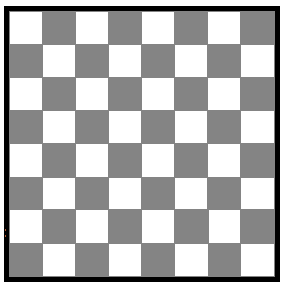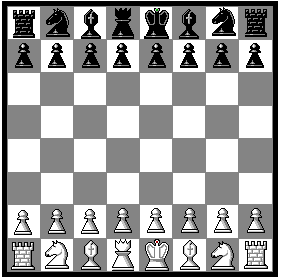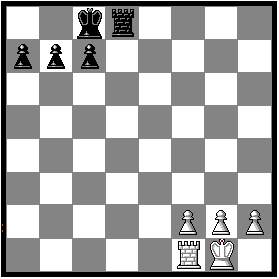
The
Chessboard
The
chessboard is a perfect square, consisting of 64 smaller squares
that alternate in color, dark and light. To set up the chessboard
correctly, the lower right hand cornet should always be a light square. Each horizontal row is called a rank; each vertical row, a
file. In the game itself, pieces, depending on their particular
scope, can move along the ranks and files, but may also move
diagonally on the chessboard.

The
Chess Pieces
The
game is played with chess pieces, also called either men or
chessmen, and pawns, a total of 32 in all, 16 for each side. Each
player, black and white, has eight pawns, two rooks, two knights,
two bishops, one queen, and one king. To verify the position of the
pieces, always remember that the queen of each side is always on its
own color; i.e.. the white queen is on a light square and the black
queen on a dark square.

Castling
Since
the king is so important and his safety is of prime strategical
consideration, the rules of chess allow castling, which puts the
king in a position of great safety. It can be done by either player,
and can be done on either side of the board; the king's side (where
the king stands) (king-side castling) or the queen's side (where the
queen stands) (queen-side castling). Castling involves moving the
king and either the queen's rook or the king's rook, depending upon
the side one is castling on, and must meet the following criteria:
First of all, neither the rook nor the king can have moved
previously. Secondly, no pieces can stand between the king and the
rook. Third, the king cannot castle into or through check. Fourth, it must be that
side's turn to move, for castling counts as a single move. And last,
the king cannot be in check. The notation used for castling is as
follows: King-side castling = 0 - 0, Queen-side castling = 0 - 0 - 0

Drawn
A
game may be drawn, or tied, under the following circumstances. a)
Both parties agree by mutual consent. b) There are insufficient
pieces on the board to force checkmate. For example, if one player
has only a king remaining, and the other has but a knight or bishop
and a king, then checkmate is impossible. c) Perpetual check ends
the game in a draw. If one side can perpetually check the opponent's
king, and does so to force a draw, the game is over. d) Repetition
of the identical position for any three times during the game ends
in a draw. This prevents constant stalling by one side. e) Stalemate
causes a draw. In this case, the king is the only piece that can
make a legitimate move, and it's only move is into check. Since a
king can't move into check, it is a stalemate. f) If, in fifty
consecutives moves, there has been no capture or no pawn has moved,
it is a drawn game.
Additional
Rules of Play
White
always makes the first opening move, and then black moves, and
thereafter each side alternates with one move a piece.
The object of the game is to capture the opposing king, known as
checkmate. Once he is captured, the game is over. A player who puts
the opposing in take may announce this by saying "check".
During most professional tournaments, strong chess players
customarily do not announce "check". For beginners, we
suggest announcing "check" every time they put the
opposing king in take.
A player shouldn't wait for his king to be captured to lose the game
if his or her position in hopeless. Often beginners lose piece after piece
and still play on. If you have a lost position, you can resign. You
resign by announcing your resignation or tipping over your own king.
Most tournament games end in resignation, rather than checkmate.
A piece or pawn is captured when the opposing piece or pawn moves
into its square. After a piece or pawn is so captured, it is taken
off the board and removed from play.
A pawn that reaches the eighth rank must be replaced by another
piece, other than a king. Usually it is replaced by a queen. This is
called queening, or pawn promotion.
In private games, there is usually no time limit to the number of
moves that can be made. However, in tournament play, a chess clock
is used, and each player has a predetermined amount of time to make
all his moves. If he/she can't make his/her moves within that time
frame, he/she loses the game.
If a player touches a piece or pawn, he/she is obligated to move
that piece or pawn. If he/she touches several pieces or pawns, the
opponent can choose which piece or pawn should be moved. For
beginners, this is important. Learn to play patiently, and don't
touch any piece or pawn until you are sure you want to move it. A
player may adjust his pieces or pawns, however, without a penalty.
The usual phrase, said beforehand, is " I adjust"
If an illegal move is made by an opponent, he/she must retract it
upon demand of the other player, and another legal move must be made
by the same piece or pawn. If the illegal move was a capture, the
capture must be made legally by another piece, if possible.
|



